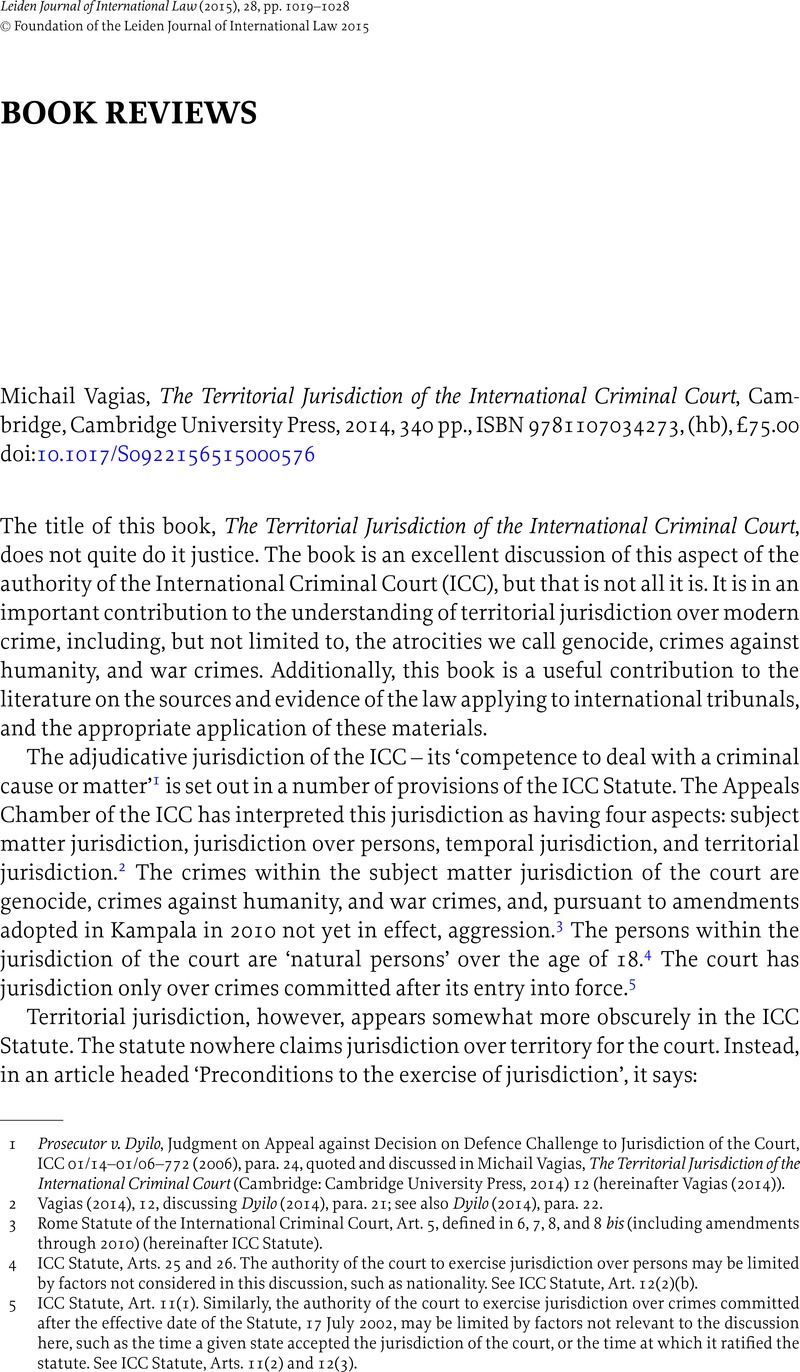No CrossRef data available.
Published online by Cambridge University Press: 30 October 2015

1 Prosecutor v. Dyilo, Judgment on Appeal against Decision on Defence Challenge to Jurisdiction of the Court, ICC 01/14–01/06–772 (2006), para. 24, quoted and discussed in Vagias, Michail, The Territorial Jurisdiction of the International Criminal Court (Cambridge: Cambridge University Press, 2014) 12CrossRefGoogle Scholar (hereinafter Vagias (2014)).
2 Vagias (2014), 12, discussing Dyilo (2014), para. 21; see also Dyilo (2014), para. 22.
3 Rome Statute of the International Criminal Court, Art. 5, defined in 6, 7, 8, and 8 bis (including amendments through 2010) (hereinafter ICC Statute).
4 ICC Statute, Arts. 25 and 26. The authority of the court to exercise jurisdiction over persons may be limited by factors not considered in this discussion, such as nationality. See ICC Statute, Art. 12(2)(b).
5 ICC Statute, Art. 11(1). Similarly, the authority of the court to exercise jurisdiction over crimes committed after the effective date of the Statute, 17 July 2002, may be limited by factors not relevant to the discussion here, such as the time a given state accepted the jurisdiction of the court, or the time at which it ratified the statute. See ICC Statute, Arts. 11(2) and 12(3).
6 ICC Statute, Art. 12(2) (bracketed material added).
7 Vagias (2014), passim. Ibid., at 12 he notes his book does not address the ‘geographical scope’ of Security Council referrals under ICC Statute, Art. 13(b); see also Dyilo (2014), para. 22.
8 See Vagias (2014), 10–11. This point is also discussed in the Foreword by John Dugard.
9 Vagias (2014), Ch. 2 discusses the background of modern territorial jurisdiction law, which is used throughout the book.
10 Vagias (2014), 17–24.
11 Vagias (2014), Chs. 3 and 4.
12 Vagias (2014), 49 and 50.
13 Report of the Secretary General pursuant to Paragraph 2 of Security Council Resolution 808, UN Doc. S/25704 (1993), para. 34; see Prosecutor v. Tadic, Decision on the Defence Motion on Interlocutory Appeal on Jurisdiction, IT-94–1 (ICTY App. Ch., 1995) para. 143; Prosecutor v. Multinovic, Decision on Draoljub Ojdonic's Motion Challenging Jurisdiction: Joint Criminal Enterprise, IT-99–37-AR72 (ICTY App. Ch., 2003), para. 10 (applying legality to allegedly new means of becoming liable for actions of others); Prosecutor v. Norman, Decision on Preliminary Motion Based on Lack of Jurisdiction, SCSL 04–14-AR72(E) (SCSL App. Ch., 2004) (treating legality as a jurisdictional issue; holding, controversially, that recruitment of child soldiers was a crime under customary international law at the time Norman allegedly acted).
14 ICC Statute, Art. 8(2)(b)(iv).
15 ICC Statute, Art. 12(2)(b).
16 Vagias (2014), Chs. 5–7.
17 Vagias (2014), Ch. 5, esp. 130–58.
18 Vagias (2014), Ch. 6, quote at 205.
19 See Vagias (2014), at 162–3.
20 Vagias (2014), at 171–85.
21 Vagias (2014), at 185–8.
22 Vagias (2014), at 172–8.